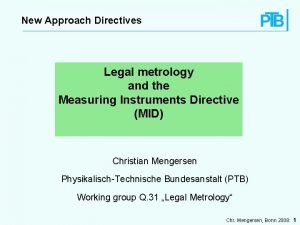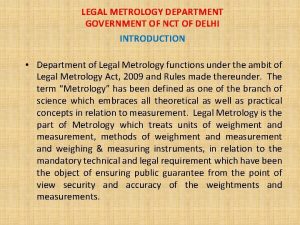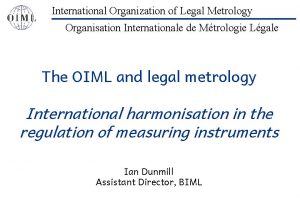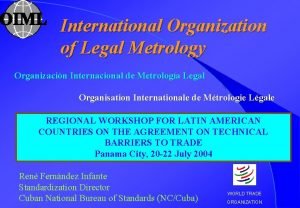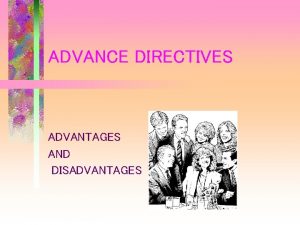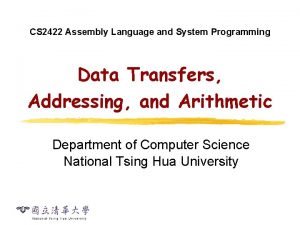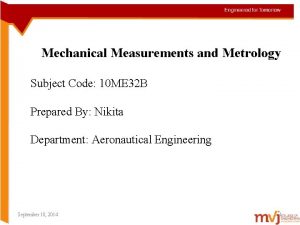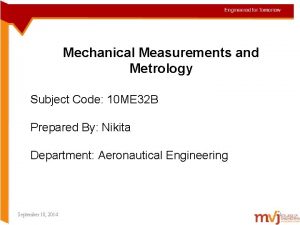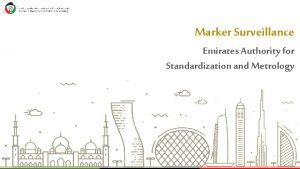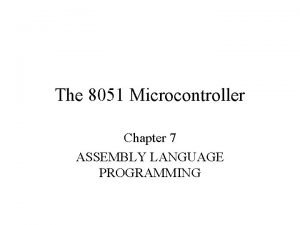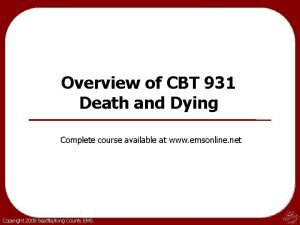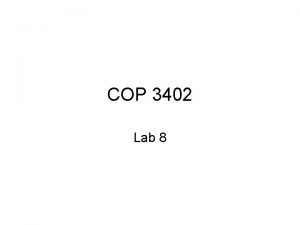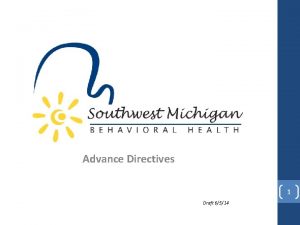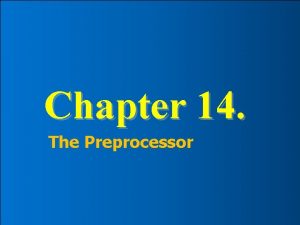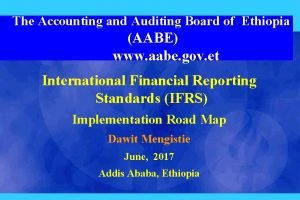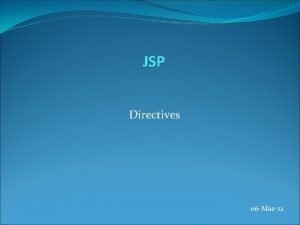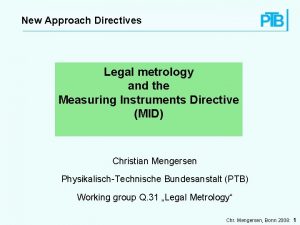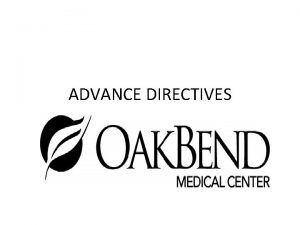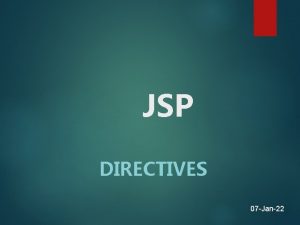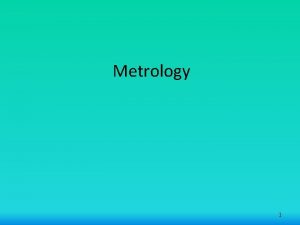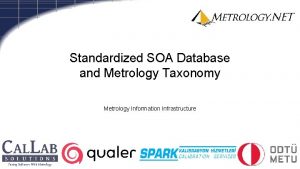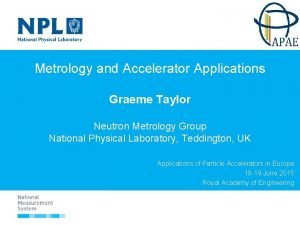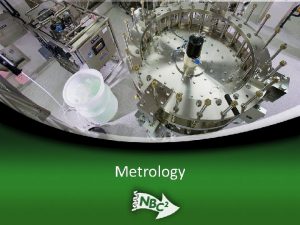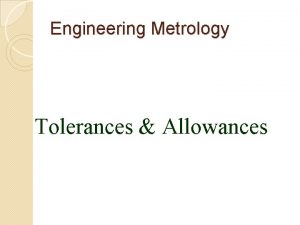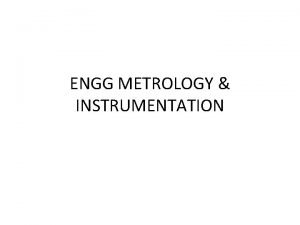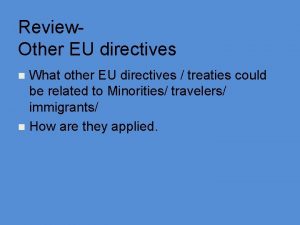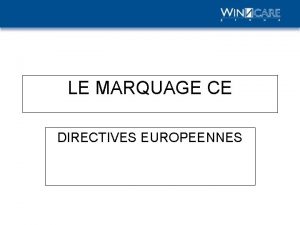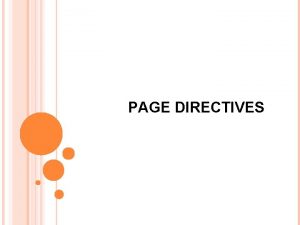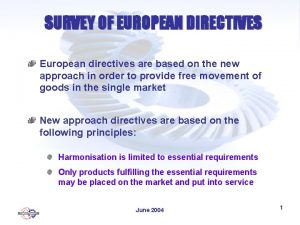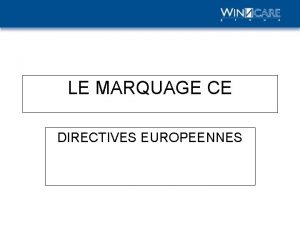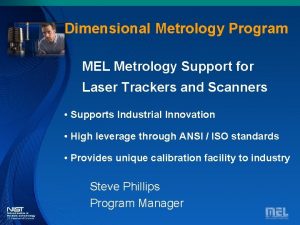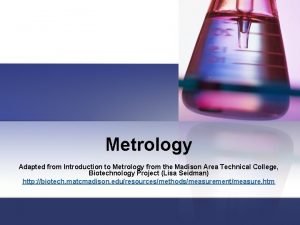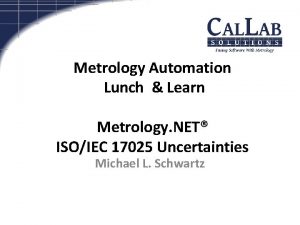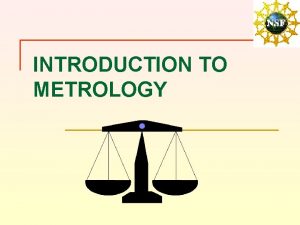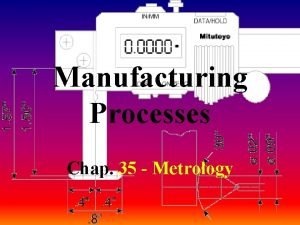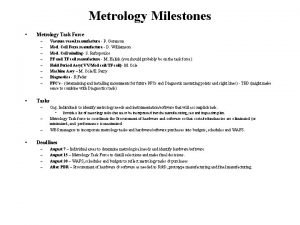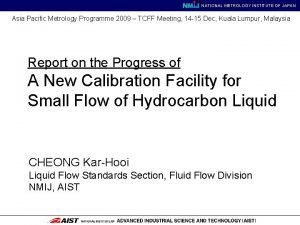New Approach Directives Legal metrology and the Measuring

























- Slides: 25

New Approach Directives Legal metrology and the Measuring Instruments Directive (MID) Christian Mengersen Physikalisch-Technische Bundesanstalt (PTB) Working group Q. 31 „Legal Metrology“ Chr. Mengersen, Bonn 2008: 1

MID Directive of the European Parliament and of the Council on Measuring Instruments with EEA relevance (2004/22/EC) = Measuring Instruments Directive = MID European Directives? bind Member States to the objectives to be achieved within a certain time-limit while leaving the national authorities the choice of form and means to be used. have to be implemented in national legislation in accordance with the procedures of the individual Member States. Chr. Mengersen, Bonn 2008: 2

Legal Metrology in the European Union Intention: Legal metrological control should not lead to barriers to free movement of measuring instruments! Starting point (before 1995): → 15 Member States with own ideas about *) „fair trade“ and „consumer protection“ → 11 “Old Approach” technical Directives → 1 “New Approach” Directive (NAWI) → WELMEC-Type approval agreements on the basis of 7 OIML-Recommendations *) 2008: 27 Member-(+ 3 Candiate-), 3 EEA-States, Switzerland, Turkey Chr. Mengersen, Bonn 2008: 3

Legal Metrology World Wide International Organisation of Legal Metrology (OIML) for Global harmonisation of legal metrology procedures – 59 member states, 57 corresponding members (2008) – about 130 specific OILM-Recommendations Chr. Mengersen, Bonn 2008: 4

Legal Metrology in Europe (2008) WELMEC (European Co-operation in Legal Metrology): 30 Members (NMI’s), 3 Associate members, 7 Observer Organisations (European Commission, OIML, . . . ), 5 Corresponding Organisations (COOMET, APLMF, . . ) Aim: Establishment of a harmonised and consistent approach to European Legal Metrology, Harmonisation of legal metrology activities, e. g. MID-Activities: WG 8 Measuring Instruments Directive + 9 Working Groups (specific measuring quantities, procedures) Chr. Mengersen, Bonn 2008: 5

Concerned measuring instruments in the MID: MI-001 Water Meters MI-002 Gas Meters and Volume Conversion Devices MI-003 Active Electrical Energy Meters MI-004 Heat Meters (MI-001 to MI-004: for utility measuring purposes) MI-005 Measuring Systems for the Measurement of Quantities of Liquids other than Water MI-006 Automatic Weighing Instruments MI-007 Taximeters MI-008 Material Measures (length, capacity measure) MI-009 Dimensional Measuring Instruments “Cables” MI-010 Exhaust Gas Analysers Chr. Mengersen, Bonn 2008: 6

MID - Basic principles: Subsidiarity / Optionality: Regulations for legally controlled instruments are limited until “placing on the market” and/or “putting into use” – Member states remain responsible for their legal metrological control (choice of controlled instruments, market surveillance), but – National metrological control should not lead to barriers to free movement of measuring instruments Preservation of the existing degree of protection in all member states: – Adequate requirements for the measuring instruments are necessary Chr. Mengersen, Bonn 2008: 7

Regulated Instruments in % Member States 100 % MI-005 Fuel Dispensers (consum. Prot. ) 97 % MI-006 Automatic Weighing Instrum. (fair trade) 97 % MI-005 Systems on Road Tankers (fair trade) 93 % MI-005 Systems for Milk (fair trade) 89 % MI-007 Taximeters (consum. prot. ) 85 % MI-010 Exhaust Gas Analysers (environment) 82 % MI-008 Material Measures: Length (consum. prot. ) 74 % MI-008 Capacity measures (taxes) 67 % - 70 % MI-009 Dimensional Measuring Instruments Resid. I Com. I Industr. Utility Meters: (consum. prot. ) 100%, 97 % MI-003 Active Electrical Energy Meters 93 % , 83 % , 74 % MI-001 Clean cold Water Meters 93 % , 93 % MI-002 Gas Meters 89 % , 85 % MI-001 Clean warm Water Meters 85 % , 89 % MI-002 Volume conversion devices 82 % , 78 % MI-004 Heat Meters Chr. Mengersen, Bonn 2008: 8

Basic procedures (Instruments): The New Approach – limits Harmonisation to essential requirements without technical instructions, concerning only the practical use – allows any technical solution fulfilling the essential requirements of use – demands presumption of conformity to the essential requirements, when EC-harmonised standards*)(CEN/ CENELEC) and EC-accepted Normative Documents*) (OIML) are the basis of the technical construction The MID is open for new technical developments *) published in the Official Journal of the European Union, C series. Chr. Mengersen, Bonn 2008: 9

Basic procedures (conformity assessment): The Global Approach – is a modular approach, offering harmonised conformity assessment procedures to the manufacturers – opens the possibility to take into account the manufacturers internal design and production control activities – allows a complete assessment until placing a measuring instrument on the market / putting into use – should provide a high level of confidence to the product MID: The conformity assessment procedures must be performed under the responsibility of a Notified Body, who is under the surveillance of a member state Chr. Mengersen, Bonn 2008: 10

Ticket for the EU-Market since 30 th October 2006 CE marking and supplementary metrology marking, affixed under the responsibility of the manufacturer: M 06 0102 = Conformity to applicable technical harmonisation Directives M = Conformity to the legal metrology Directive 2004/22/EC 06 = Year of affixing the CE- and the metrology marking 0102 = Identification no. of the notified body, responsible for the conformity assessment procedure for ‘placing on the market’ and/or ‘putting into use’ Chr. Mengersen, Bonn 2008: 11

Valid in 27 EG-, 3 EEA-States, Switzerland, Turkey Austria Belgium Bulgaria Cyprus Czech Republic Denmark Estonia Finland France Germany Greece Hungary Ireland Italy Latvia Lithuania Luxembourg Malta Netherlands Poland Portugal Romania Slovakia Slovenia Spain Sweden United Kingdom Iceland Liechtenstein Norway Switzerland Turkey Chr. Mengersen, Bonn 2008: 12

Structure of the MID 1) Articles, regulating the procedures: Definitions, Procedures for implementation, obligations, regulations, Criteria to be satisfied by the notified bodies, Necessary technical documentation from manufacturer, Safeguard clause in the case of non conformity, Changes and further development of the MID 2) General Essential Requirements (Annex I) 5) Conformity Assessment Procedures (Annexes A - H 1) 6) Instrument Specific Essential Requirements (Annexes MI-001 to MI-010) Chr. Mengersen, Bonn 2008: 13

Essential Requirements: All instruments (Annex I) Correct measurement: Allowable Errors, Durability Influence Quantities: Mechananic, Climatic, Electromagnetic Suitability for use, reproducibility Verifiability: Metrolog. relevant parts, also for instruments in use Additional functionalities, not under legal control Protection against corruption (Hard- and Software) Easy identification of metrological relevant Hard- and Software Information to accompany the instruments Indication of the result: (Metrologically controlled display for the consumer as the basis of the price to pay) Further processing of data to conclude trading transaction Chr. Mengersen, Bonn 2008: 14

Instrument specific Essential Requirements (Annexes MI-001 to MI-010) Rated operating conditions (climatic, mechan. , electromagn. ) Maximum permissible Errors (MPE) at rated operating conditions Permissible effects of disturbances Indication of the result Allowed Conformity Assessment Procedures If applicable: Accuracy classes Conditions for putting into use Suitability Durability Requirements for sub assemblies with conformity assessment Chr. Mengersen, Bonn 2008: 15

European harmonised standards Presumption of conformity with the essential requirements in full or in part if the instrument complies with : – Harmonised European Standard (CEN/CENELEC) – Normative Documents, e. g. drawn up by OIML, in full or in part referenced in the C series of the Official Journal of the European Communities Where an instrument not complies with referenced standards or documents, the Notified Body is in charge that the instrument meets the provisions of the Directive Chr. Mengersen, Bonn 2008: 16

Simplified flow chart of conformity assessment procedures (Global Approach) 1 / Module H (“Blue Book”: www. newapproach. org) Chr. Mengersen, Bonn 2008: 17

Essential Conformity Assessment Procedures Mod F Product verification Mod B Type examination Manufacturer Mod D M 06 0102 Production quality assurance Design examination, Full quality assurance Mod H 1 Chr. Mengersen, Bonn 2008: 18

Common features for Mod D and H 1 – Modules D and H 1 do not require a certified quality system according to e. g. EN ISO 9001, 9002 or 9003 – A certified quality system (EN ISO or equivalent) provides a useful means of establishing compliance with the directive – The quality system must take into consideration the specific requirements of the product – The surveillance (first/periodic audits, unexpected visits, product tests) is under the responsibility of the Notified Body. The responsibility can not be delegated! Chr. Mengersen, Bonn 2008: 19

Demands on the Notified Bodies (Article 12) – Impartiality, free from all pressures and inducements – Highest degree of professional integrity and requisite competence in the field of metrology – Ability to carry out all the tasks assigned to such bodies by the Annex for which it has been notified – Sound technical and vocational training, covering all conformity assessment tasks for which it is designated – Professional secrecy with regard to all information obtained in the course of exercising their duties – Closing of a civil liability insurance, if its civil liability is not covered by the Member State under national law Member States are responsible for the designation of NB‘s: Chr. Mengersen, Bonn 2008: 20

Duties of the member states (Articles) – Appointment of suitable Notified Bodies, Supervision of the Notified Bodies (11, 12) – Market surveillance: Check that affixing and use of the CE + M marking is correct, withdrawing instruments with unduly fixed marking → safeguard clause (18, 19) – Notification to the Commission and to the other Member States about the restriction of free movement of an instrument due to unduly fixed CE + M markings – Notification to the “Measuring Instruments Committee” concerning changes, new normative documents etc (15) – Notification to the “Standing Committee” concerning new or invalide European harmonised standards (14) Chr. Mengersen, Bonn 2008: 21

Summery: The MID – removes barriers of trade for 10 types of instruments – is open for new technical solutions – offers European conformity assessment procedures – considers the competence of the manufacturer But there is a need of support by – technical standardisation (CEN/CENELEC, OIML) – standardisation of the procedures (WELMEC, OIML) – surveillance of correct use of the European procedures (Member States, European Commission) Chr. Mengersen, Bonn 2008: 22

MID and the Global Market A manufacturer in a third country is responsible for the design and production of a measuring instrument in the same way as a manufacturer established in a Member State. A physical or legal person, established within the EU, is responsible for the CE marking and the necessary documentation (e. g. the manufacturer, his authorised representative, the importer or the person responsible for placing the product on the Community market). The customs authorities will check the formal correctness. Mutual recognition agreements between the Community and third countries can facilitate the conditions for the manufacturers of these countries. Chr. Mengersen, Bonn 2008: 23

The perspective: The MID offers new Conformity Assessment Procedures, especially applicable for electronic and software controlled measuring instruments. The MID removes barriers to free movement of measuring instruments which are under national legal control. The European Union is Partner in the Global Market for measuring instruments. More valuable information: www. newapproach. eu (Directives, harm. Standards etc. ) www. welmec. org (Guides, country infos etc. ) www. ptb. de Thank You ! Chr. Mengersen, Bonn 2008: 24

 New approach directives
New approach directives Legal metrology officer
Legal metrology officer International organisation of legal metrology
International organisation of legal metrology International organisation of legal metrology
International organisation of legal metrology New-old approach to creating new ventures
New-old approach to creating new ventures Disadvantages of advance directives
Disadvantages of advance directives Data related operators and directives in assembly language
Data related operators and directives in assembly language Saudi standards, metrology and quality organization
Saudi standards, metrology and quality organization Examples of product metrics
Examples of product metrics Working principle of tool makers microscope
Working principle of tool makers microscope Metrology and measurements subject code
Metrology and measurements subject code Emirates authority for standardization and metrology logo
Emirates authority for standardization and metrology logo What are the approaches to measuring performance
What are the approaches to measuring performance 8051 assembly language programming examples
8051 assembly language programming examples What are the types of advance directives
What are the types of advance directives Sic assembler
Sic assembler Assembly directives of 8086
Assembly directives of 8086 What are the types of advance directives
What are the types of advance directives Compiler control directives in c
Compiler control directives in c Accounting and auditing board of ethiopia
Accounting and auditing board of ethiopia Jsp taglib directive example
Jsp taglib directive example Advance directives
Advance directives Ltorg in system programming
Ltorg in system programming Mike towr
Mike towr Forest service directives
Forest service directives For imperative statement 2 pass assembler
For imperative statement 2 pass assembler
